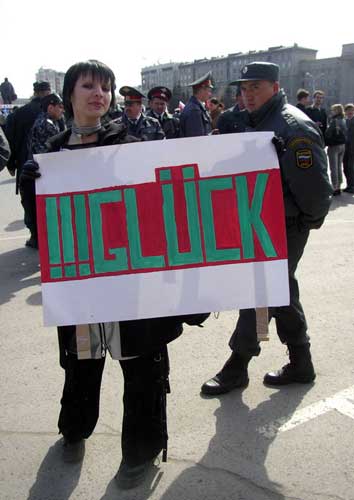 |
| 20.02.2009
- 29.03.2009 Art and Law I: CAT. Monstration Opening:
Friday 20.02.2009, 8PM |
||||||
|
CAT. Monstration The actions of the group CAT (Contemporary Art Terrorism) founded in Novosibersk in 2003 by Maksim Neroda, Ekaterina Drobyševa and Artem Loskutov and active until 2006) could be understood as interventions in urban space. These actions were supposed to reclaim urban space as a platform for artistic and political expression- a new and topical strategy compared to the Soviet Union where public space was reserved solely for official political propaganda and artistic actions took place either in private space or in nature. Their art sought to be 'timely' (russ. CBOeBPeMeHHO), as opposed to 'contemporary' (russ. COBPeMeHHO)-1. "Timely art has no author. Its body is the communication between members inside the group", as it is described in the Statement about Timely Art-2 : "Its work is the external results of this communication. Artworks of 'timely art' have no material value, but are made up of the information which the viewer is given about alternative functional mechanisms in society [...]. [...] 'Timely art' is political art. [...] 'Timely art' elevates claims to its presence and to its involvement in the art of shaping people's lives." An example of an action which is 'timely art' is a humorous protest action against the introduction of student fees in 2004. A banner with the slogan "Learn, learn and keep learning," a quote from Lenin, was placed before the base of the Lenin memorial in Novosibersk. The police removed the banner and arrested the artists on a charge of disturbing public order. When asked who was the initiator of the action, CAT replied that it was Lenin himself. They had only brought together what belonged together - the quotation and its source. In a series of Monstrations from 2004 on, which can be understood as counterparts to the classical May Day demonstrations, individual banners with apolitical, often poetic or non-rational slogans were used: "Catch the Stallion", "Where am I?", "I'm for it", "Down with the Exploitation of Siberian Wildlife in Contemporary Art", or a simple white line on a red ground.-3 Even before the banners for the 2004 Monstration could be unfurled they were already accused of being "anti-globalist Solutions", and in connection with the Monstration the members of CAT were arrested and sentenced to pay a fine. In the actions of CAT there is an unmistakable echo of Joseph Beuys and his idea of social sculpture where every individual can deal creatively to contribute to the good of society and have a formative influence. But in the specific context of Russian society, where participatory democracy is a practically unknown concept, CAT repeatedly came into conflict with the law, or at least with what the authorities considered this to be. In some cases they were acquitted; in others sentenced to fines, which CAT paid, ironically, as part of an artistic action: The Penalty Has Big Eyes, 2004. The city became an exhibition space and the Russian bureaucratic structure was transformed, unwillingly, into a medium for exposing the functional incapability and absurdity of the political power structure in today's Russia. In addition, the media, especially television, was usually on site for the actions and reported on them, providing support and even protection to CAT. The
exhibition CAT. Monstration documents actions on the borderline
between art and lawbreaking, with the accompanying police and juridical
documents and reports from the mass media to demonstrate under exactly
which circumstance art becomes a crime. |
|||||
| 1-This
pun functions in Russian through the switching of a few letters. 2-Dekret über die rechtzeitige Kunst (A Statement about Timely Art). In: http://www.cat-group.info/dekret_deu.html. 3-“Down with the Exploitation of Siberian Wildlife in Contemporary Art!”, refers to the boom in use of Russia clichés such as alcoholism or brutality by western curators; the white line on a red ground calls to mind the work Ideal Slogan, 1972, by the artist duo Vitalij Komar and Aleksandr Melamid. |
||||||
| sponsored by: | |||||
